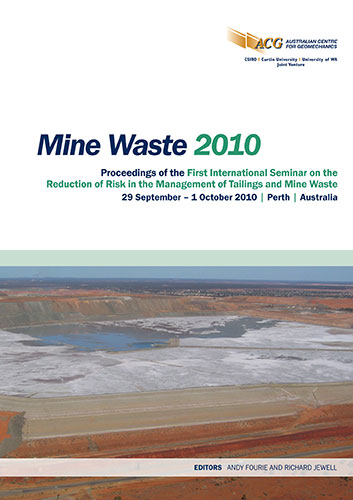Geochemistry of thallium in lead-zinc tailings

|
Authors: Allen, DG |
DOI https://doi.org/10.36487/ACG_rep/1008_28_Allen
Cite As:
Allen, DG 2010, 'Geochemistry of thallium in lead-zinc tailings', in R Jewell & AB Fourie (eds), Mine Waste 2010: Proceedings of the First International Seminar on the Reduction of Risk in the Management of Tailings and Mine Waste, Australian Centre for Geomechanics, Perth, pp. 321-331, https://doi.org/10.36487/ACG_rep/1008_28_Allen
Abstract:
Procedures for characterising mining wastes in Western Australia tend to focus on potential for producing acid rock drainage (ARD). However, many types of mining waste produce neutral or slightly alkaline drainage, which is usually considered environmentally benign from a geochemical perspective. This paper provides an example of potential contamination of the environment by the heavy metal thallium in alkaline seepage from lead-zinc mines. By understanding the geochemistry of thallium and other potential contaminants, an appropriate cover design for two tailings storage facilities (TSFs) in the north of Western Australia have been developed. The effectiveness of the soil covers has been demonstrated in a controlled field trial and by ongoing groundwater monitoring.
References:
DITR (2007) Managing Acid and Metalliferous Drainage, Department of Industry, Tourism and Resources, February
2007.
GARD Guide (2010) Global Acid Rock Drainage Guide, The International Network for Acid Prevention, Section 2.4.1,
John Peter, A.L. and Viraraghavan, T. (2005) Thallium: a Review of Public Health and Environmental Concerns,
Environmental International, Vol. 31, pp. 493–501.
Nriagu, J.O. (1998) Thallium in the Environment, Volume 29 in the series Advances in Environmental Science and
Technology, John Wiley & Sons Inc.
Sobek, A.A., Schuller, W.A., Freeman, J.R. and Smith, R.M. (1978) Field and Laboratory Methods Applicable to
Overburdens and Minesoils, EPA-600/2-78-054.
Geochemistry of thallium in lead-zinc tailings D.G. Allen
332 Mine Waste 2010, Perth, Australia
© Copyright 2025, Australian Centre for Geomechanics (ACG), The University of Western Australia. All rights reserved.
View copyright/legal information
Please direct any queries or error reports to repository-acg@uwa.edu.au
View copyright/legal information
Please direct any queries or error reports to repository-acg@uwa.edu.au